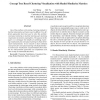Free Online Productivity Tools
i2Speak
i2Symbol
i2OCR
iTex2Img
iWeb2Print
iWeb2Shot
i2Type
iPdf2Split
iPdf2Merge
i2Bopomofo
i2Arabic
i2Style
i2Image
i2PDF
iLatex2Rtf
Sci2ools
ICDM
2002
IEEE
2002
IEEE
Concept Tree Based Clustering Visualization with Shaded Similarity Matrices
One of the problems with existing clustering methods is that the interpretation of clusters may be difficult. Two different approaches have been used to solve this problem: conceptual clustering in machine learning and clustering visualization in statistics and graphics. The purpose of this paper is to investigate the benefits of combining clustering visualization and conceptual clustering to obtain better cluster interpretations. In our research we have combined concept trees for conceptual clustering with shaded similarity matrices for visualization. Experimentation shows that the two interpretation approaches can complement each other to help us understand data better.
Better Cluster Interpretations | Conceptual Clustering | Data Mining | ICDM 2002 | Shaded Similarity Matrices |
| Added | 14 Jul 2010 |
| Updated | 14 Jul 2010 |
| Type | Conference |
| Year | 2002 |
| Where | ICDM |
| Authors | Jun Wang, Bei Yu, Les Gasser |
Comments (0)

